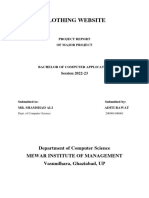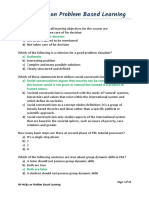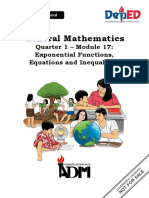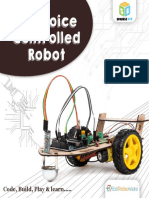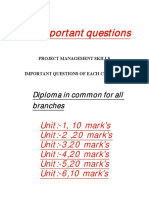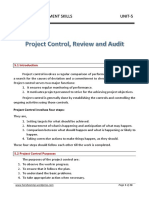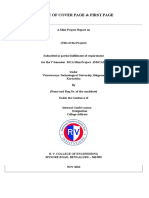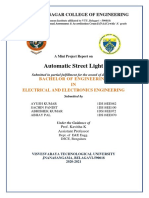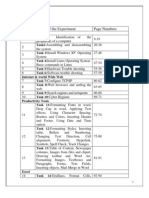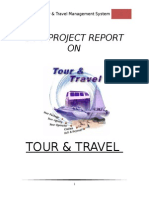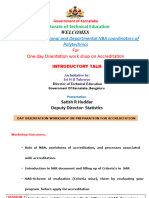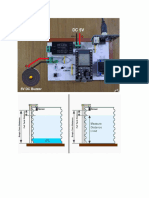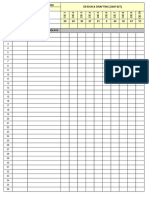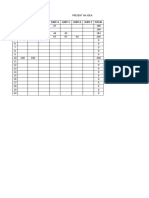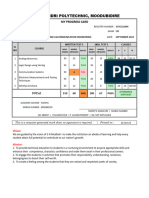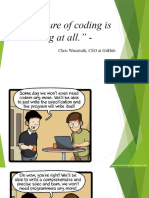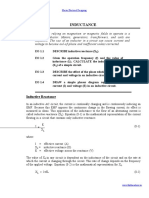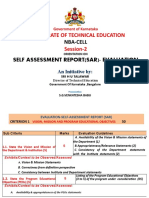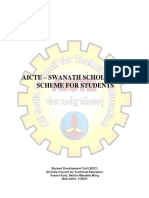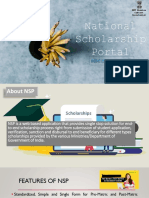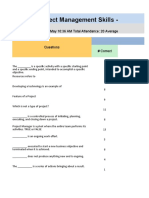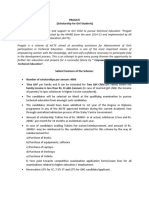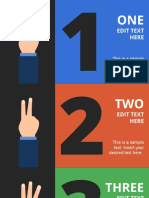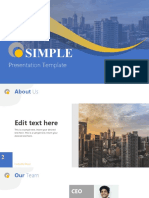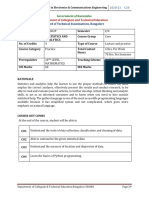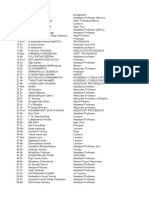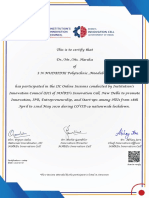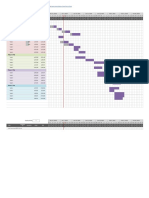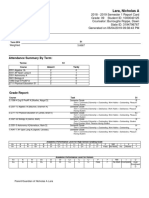Department of Collegiate and Technical Education
Department of Collegiate and Technical Education
Uploaded by
Harsha SamagaraCopyright:
Available Formats
Department of Collegiate and Technical Education
Department of Collegiate and Technical Education
Uploaded by
Harsha SamagaraOriginal Title
Copyright
Available Formats
Share this document
Did you find this document useful?
Is this content inappropriate?
Copyright:
Available Formats
Department of Collegiate and Technical Education
Department of Collegiate and Technical Education
Uploaded by
Harsha SamagaraCopyright:
Available Formats
Diploma
in Electronics & Communications Engineering 2020-21 C20
Government of Karnataka
Department of Collegiate and Technical Education
Board of Technical Examinations, Bangalore
Course Code 20PM01T Semester II
Project Management
Course Title Course Group PM
Skills
No. of Credits 4 Type of Course Activity based study
6 Hrs Per Week (2Theory +4 hrs
Total Contact of classroom activities)
Course Category Theory with Activities
Hours 78 Hrs Per Semester
Prerequisites 10thLevel Mathematics Teaching 4 hrs per week classroom
Scheme sessions dedicated to case studies
& activities
CIE Marks 50 SEE Marks 50
RATIONALE
Project Management is a confluence of Management principles and Engineering
subject area. This course enables the students to develop conceptualisation of
Engineering Management principles and apply the same for their engineering projects, in
their domains, example, Software Development project or Construction Project and so on.
The course integrates three core areas of Planning, Execution and Auditing of Projects.
1. COURSE SKILL SET
Student will be able to:
8. Understand what constitutes a project, Plan for the execution of the project by
breaking into manageable work units, and Prepare necessary project artifacts
9. Track and control the Project while preparing verifiable records for Project
Inspections and Audits
10. Inspect and Audit projects for Milestones or other project completion criteria and
other metrics, Defects and remediation, Project learnings
11. Gain knowledge and develop curiosity on latest technology trends in Project
management
Department of Collegiate & Technical Education Bengaluru-560001 Page 75
Diploma in Electronics & Communications Engineering 2020-21 C20
2. COURSE OUT COMES
At the end of the course, student will be able to
Apply the concepts of Project Management to real projects which are expressed
CO1
in the form of the Project reports or Engineering drawings
Estimate Project resources needed – Time, Material and Effort, and Plan for
CO2
execution
Understand, analyse and assess the risks involved in a project and plan for
CO3 managing them
CO4 Use Project Management Software and processes to track and control Projects
CO5 Conduct inspection of Projects and audit progress and bills
Understand the Digital Technology trends in Project management and concepts
CO6
like Smart cities
3. SUGGESTED SPECIFICATION TABLE WITH HOURS & MARKS
TEACHING MARKS DISTRIBUTION(THEORY)
UNIT
UNIT TITLE HOURS R U A
NO TOTAL
(L-T-P) LEVEL LEVEL LEVEL
1 Introduction 02-00-04 8 8 4 20
2 Project Administration 06-00-12 8 12 20 40
3 Project Lifecycle 04-00-08 8 12 20 40
4 Project Planning, Scheduling 06-00-12 8 12 20 40
and Monitoring
Project Control, Review and
5 06-00-12 8 12 20 40
Audit
6 Digital Project Management 02-00-04 8 8 4 20
Total 26-00- 48 64 88 200
52=78
Legends: R = Remember; U = Understand; A = Apply and above levels (Bloom’s revised
taxonomy)
4. DETAILS OF COURSE CONTENT
The following topics/subtopics is to be taught and assessed in order to develop Unit Skill sets
for achieving CO to attain identified skill sets.
Department of Collegiate & Technical Education Bengaluru-560001 Page 76
Diploma in Electronics & Communications Engineering 2020-21 C20
UNIT NO Unit skill set Hours
(In cognitive Topics / Subtopics L-T-P
domain)
1 Introduction Use Basic Science, Maths Introduction and definition, 02-00-
skills to understand Features of a Project, Types of 04
Project management and Projects, Benefits and Obstacles
project planning, in Project Management, Project
execution and control. Management Profession, Role of
Project manager, Consultants,
Project and Operation, Project
Management Process, Project
Scope
2 Project Able to develop WBS, Project Administration, Project 06-00-
Administration PEP and PM processes Team, Project Design, Work 12
for Project with given Breakdown Structure (WBS),
inputs Project Execution Plan (PEP),
Systems and Procedure Plan,
Project Direction,
Communication and Co-
ordination, Project Success
Case Study I
3 Project Use project Project Life Cycle, Phases - 04-00-
Lifecycle administration and Project Planning, Project 08
project lifecycle Execution, Project Closure,
knowledge to Assess and Project Risks, Project Cost Risk
plan for project risk Analysis, Time and Cost
overruns
Case Study 2a
4. Project Able to develop a Project Planning Function, 06-00-
Planning, Project detailed project plan Structure, Project Scheduling, 12
Scheduling and given the inputs on Project monitoring and Project
Project manpower, funds evaluation
Monitoring availability and time
and availability Case Study 2b
Implementation
5.Project Use Project Management Project Control, Problems of
Control, Review lifecycle knowledge to Project Control, Gantt Charts,
and Audit Control project Milestone Charts, Critical Path
parameters, review and Method (CPM), Network 06-00-
audit project Technique in Project Scheduling,
12
performance Crashing Project Duration
through Network, Project
Review, Initial Review,
Performance Evaluation,
Department of Collegiate & Technical Education Bengaluru-560001 Page 77
Diploma in Electronics & Communications Engineering 2020-21 C20
Abandonment Analysis, Project
Audit
Case Study 2c
6.Digital Project Understand latest trends Digital Technology trends in
Management of digital technologies Project management, Cloud
impacting the domain of Technology, IoT, Smart cities,
project management and Data and analytics, case studies 02-00-
application of the same 04
in multiple scenario Case study 3
5. MAPPING OF CO WITH PO
CO Course Outcome PO UNIT CL Sessions TOT
Mapped Linked R/U/A in Hrs AL -
Marks
Understand the concepts of 1, 2, 5, 7 1, 2 R/U/A
Project Management in relation
to real projects which are 06 10
expressed in the form of the
CO1
Project reports or Engineering
drawings
Case Study - I
CO2 Estimate Project resources 1, 2, 3, 7 2, 3 R/U/A
needed – Time, Material and 18 20
Effort, and Plan for execution
Case study – 2a
CO3 Evaluate the risks involved in a 1,2,3,7 2,3 R/U/A 12 20
project and Plan for managing
them
Case Study - 2a
Department of Collegiate & Technical Education Bengaluru-560001 Page 78
Diploma in Electronics & Communications Engineering 2020-21 C20
CO4 Use Project Management 1, 4, 6, 7 4 R/U/A
methods with Software and/or
processes to track and control 18 20
Projects
Case Study – 2b
CO5 Conduct inspection of Projects 1, 2, 5, 7 5 R/U/A
and audit progress and bills 18 20
Case Study 2c
CO6 Understand the Digital 1, 5, 7 6 R/U/A
Technology trends in Project
management, and Engineering 06 10
Industries
Case Study 3
78 100
CO’s P rogramme Outcomes ’s)
(PO
1 2 3 4 5 6 7
Project Management CO1 3 3 0 0 2 0 1
CO2 3 3 3 0 0 0 1
CO3 3 0 0 3 0 3 1
CO4 3 0 0 3 0 3 1
CO5 3 2 0 0 2 0 1
CO6 3 0 0 0 2 0 2
Level 3- Highly Mapped, Level 2-Moderately Mapped, Level 1-Low Mapped, Level 0-
Not Mapped
7. INSTRUCTIONAL STRATEGY
These are sample Strategies, which teacher can use to accelerate the attainment of the
various course outcomes
1. Explicit instruction will be provided in intervention classes or by using different
differentiation strategies in the main classroom.
Department of Collegiate & Technical Education Bengaluru-560001 Page 79
Diploma in Electronics & Communications Engineering 2020-21 C20
2. Lecturer method (L) does not mean only traditional lecture method, but different type of
teaching method and media that are employed to develop the outcomes.
3. Observing the way their more proficient peers use prior knowledge to solve current
challenges and persevere in problem solving will help struggling students to improve
their approach to engaging with rich contextual problems.
4. Topics be introduced always with a reallife example and then answering What, how, why
and when.
5. The teacher is able to show different ways to solve the same problem and encourage the
students to come up with their own creative ways to solve them.
6. In a perfect world, teacher would always be able to demonstrate how every concept can
be applied to the real world - and when that's possible, it helps improve the students'
understanding. When a concept cannot be applied in that manner, we can still share how
it might be applied within mathematics.
8. SUGGESTED LEARNING RESOURCES:
SlNo. Author Title of Books Publication/Year
Dr. Lalitha Project Management Himalaya Publishing, 2019
Balakrishnan &
1
Dr. Gowri
Ramachandran
Shailesh Kumar Complete Guide to Digital Apress, 2019
2
Shivakumar Project Management
Project planning, analysis,
3 Prasanna Chandra selection, implementation Tata McGraw Hill
and review
4 Gopala Krishnan Project Management Mcmillan India Ltd.
9. COURSE ASSESSMENT AND EVALUATION CHART
Sl. No Assessment Duration Max Conversion
marks
CIE Assessment 1 Average of three
( Written Test -1) written tests
1 At the end of 3rd week 80 minutes 30
30
CIE Assessment 2
(Written Test -2)
2 At the end of 7th week 80 minutes 30
Department of Collegiate & Technical Education Bengaluru-560001 Page 80
Diploma in Electronics & Communications Engineering 2020-21 C20
Sl. No Assessment Duration Max Conversion
marks
CIE Assessment 3
(Written Test -3)
3 At the end of 13th week 80 minutes 30
CIE Assessment 4 Average of three
(Group Assignment -1)
20
4 At the end of 5th week 60 minutes 20
CIE Assessment 5
(Group Assignment -2 )
5 At the end of 9th week 60 minutes 20
CIE Assessment 6
(Individual Student
activity/Assignment) At
6 the end of 11th week 60 minutes 20
Total Continuous Internal Evaluation (CIE) Assessment 50
Semester End
8 Examination (SEE) 3 Hrs 100 50
Assessment (Written Test)
Total Marks 100
Note:
1. SEE (Semester End Examination) is conducted for 100 Marks theory course for a time
duration of 3 Hrs
2. Three CIE (written test), each of 30 marks for a time duration of 80 minutes shall be
conducted. Also, three CIE (MCQ or Quiz/Group Assignment/Individual student
activity or assignment) each of 20 marks for the time duration of 60 minutes shall be
conducted. Any fraction at any stage during evaluation will be rounded off to the next
higher digit
3. Assessment of assignment and student activity is evaluated through
appropriate rubrics by the respective course coordinator. The secured mark in each
case is rounded off to the next higher digit.
10 DETAILED COURSE CONTENT
Unit No DETAILED COURSE CONTENT CONTACT TOTAL
And Name HRS
1.1 Introduction 3
Department of Collegiate & Technical Education Bengaluru-560001 Page 81
Diploma in Electronics & Communications Engineering 2020-21 C20
Unit No DETAILED COURSE CONTENT CONTACT TOTAL
And Name HRS
1.2 Meaning of Project
1.3 Definition and No Change Mode
1.4 Features of a Project
1. 6
Introduction 1.5 Types of Projects
1.6 Benefits of Project Management
1.7 Obstacles in Project Management
1.8 Project Management – A Profession
1.9 Project Manager and His Role
1.10 Project Consultants
1.11 What is Operation? 3
1.12 Difference between Project and Operation
1.13 What is Process in Project Management and
Process Groups?
1.14 What is Scope? Difference between Project
Group Objectives and
1.15 Project Scope
2. Project 2.1 Essentials of Project Administration 3 18
Administrat 2.2 Project Team
ion 2.3 Project Design
2.4 Work Breakdown Structure (WBS)
2.5 Project Execution Plan (PEP) 6
2.6 Contracting Plan
2.7 Work Packing Plan
2.8 Organisation Plan 3
2.9 Systems and Procedure Plan
2.10 Project Procedure Manual
2.11 Project Diary 3
2.12 Project Execution System
2.13 Project Direction
2.14 Communication in a Project 3
2.15 Project Co-ordination
Department of Collegiate & Technical Education Bengaluru-560001 Page 82
Diploma in Electronics & Communications Engineering 2020-21 C20
2.16 Pre-requisites for Successful Project
Implementation
3. Project 3.1 Introduction 6 12
Lifecycle 3.2 Phases of Project Life Cycle
3.3 Project Management Life Cycle – General
3.4 Project Planning
3.5 Project Execution
3.6 Project Closure
3.7 Project Risks 3
3.8 Types of Risks: Illustrations
3.9 Risk Assessment Techniques with Illustrations
3.10 Project Cost Risk Analysis 3
3.11 Estimating Time and Cost Overrun Risks
3.12 Organisation/Procedural/Systemic Reasons
for Project Cost Overruns
3.13 Time Overruns
4. Project 4.1 Introduction 6 18
Planning,
Scheduling 4.2 Nature of Project Planning
and
Monitoring 4.3 Need for Project Planning
4.4 Functions of Project Planning
4.5 Steps in Project Planning
4.6 Project Planning Structure
4.7 Project Objectives and Policies
4.8 Tools of Project Planning
4.9 Project Scheduling 6
4.10 Time Monitoring Efforts
4.11 Bounding Schedules
4.12 Scheduling to Match Availability of
Manpower
4.13 Scheduling to Match Release of Funds
4.14 Problems in Scheduling Real-life Projects
4.15 Introduction 3
Department of Collegiate & Technical Education Bengaluru-560001 Page 83
Diploma in Electronics & Communications Engineering 2020-21 C20
4.16 Situation Analysis and Problem Definition
4.17 Setting Goals and Objectives
4.18 Generating Structures and Strategies
4.19 Implementation
4.20 What is Project Evaluation? 3
4.21 Why is Project Evaluation Important?
4.22 What are the Challenges in Monitoring and
Evaluation?
5. Project 5.1 Introduction 6 18
Control,
Review and 5.2 Projected Control Purposes
Audit 5.3 Problems of Project Control
5.4 Gantt Charts
5.5 Milestone Charts
5.6 Critical Path Method (CPM) 6
5.7 Construction of a Network
5.8 Network Technique in Project Scheduling
5.9 Crashing Project Duration through Network
5.10 Project Review 3
5.11 Initial Review
5.12 Post Audit
5.13 Performance Evaluation
5.14 Abandonment Analysis
5.15 Objectives of Project Audit 3
5.16 Functions of Project Auditor
5.17 Project Audit Programme
5.18 Difficulties in Establishing Audit Purpose and
Scope
6. Digital 6.1 Digital Technology trends in Project 1 6
Project management
Management
6.2 Cloud Technology, IoT, AR and VR applications 1
in Project management, Smart Cities
Department of Collegiate & Technical Education Bengaluru-560001 Page 84
Diploma in Electronics & Communications Engineering 2020-21 C20
6.3 Data Science and Analytics in Project 1
Management
6.4 Case Studies 3
Case Studies:
Please note: The Tutors can either use the following Case studies and activities or Design
on their own, with the overall Learning Outcomes being met.
Case Study I: Residential House – Project Execution Plan
1. Dr. Sunil Kulkarni wants to build a house on his 9000 square feet (90x100) vacant plot
in Bengaluru. His requirements were given below.
i) He lives with his wife, parents and two college going children.
ii) He likes open space around his house and likes to do gardening during free
time
iii) His wife teaches Yoga and about 30 middle aged and old people attend the
daily sessions.
iv) He has a budget limitation of INR 230,00,000 for this project and wants to
present to his wife on their 20th wedding anniversary which is 18 months
away.
v) His parents can not climb stairs and hence prefer a ground floor room
vi) All the rooms should have attached bathrooms
How-ever the Civil contractor who took the work, overshot the time and money available
and hence Dr Sunil was unhappy with the Architect firm who recommended the Contractor.
Task:
• Split the class into groups of three
• Ask them to prepare 2D drawings – with Plan, Elevation, Sections and perspectives.
• Prepare the detailed WBS, a Project execution plan and Project communication plan
for contractors
• Estimate the quantities
• Discuss on the possible reasons for delay and methods with which performance to
both time and budget could have been achieved
• Present it in a seminar, with each group getting 5-10 minutes to present their idea.
Department of Collegiate & Technical Education Bengaluru-560001 Page 85
Diploma in Electronics & Communications Engineering 2020-21 C20
Case Study 2a:
The Columbus Hospital proposed in Hubli is a 200 bed speciality private hospital for
treatment of Cancer. The hospital will come up on a 12 acre plot between Hubli-Dharwad. A
leading construction company has come forward to complete the hospital works from
concept to commissioning in 9 months. The promoters are willing to spend a premium to
complete the hospital in 9 month time and are not particular about type of construction, ie,
RCC, Steel frame etc. The key requirements are as follows:
vi) 200 bed hospital of which 40 are for critical care (ICU), 40 for pre and post
Operative care
vii) 4 Operation Theatres - 2 Major (Minimum 800 SFT each) and 2 minor (minimum
400 sft each)
viii) One full fledged Diagnostic laboratory (1500 Sft)
ix) One 24x7 pharmacy (360 Sft min)
x) Doctors rooms, Nurses enclosures, Change rooms
xi) Office with billing counters (min 2000 sft) for all administrative staff
xii) Wheel chair parking bays, Stretcher parking bays in all floors
xiii) One Cafetaria with 50 person capacity
xiv) One conference room with Multimedia equipment (300 sft min)
xv) Parking for ambulances, 4 wheelers, two wheelers
xvi) Reception and enquiry counter
xvii) All amenities should be accessible for disabled persons
xviii) Incinerator, Waste storage and disposal area
xix) Generator and fuel storage area
Discuss
vii) The various alternative approaches available to complete the hospital.
viii) Look into National Building Code and BIS standards for arriving at approximate
(+/- 10%) super built-up area required, amenities to be planned
ix) The various phases of the project according to Project lifecycle and durations
x) Prepare the detailed WBS, Project Organisation required and Project Dairy
template
xi) Prepare a Project Plan with risks involved and the risk management plan.
xii) Estimate the cost of time overrun if the project is delayed by 114 calendar days
due to issues with approvals
Case Study 2b:
For case study 2 above, prepare an Implementation Plan using a spreadsheet software.
Discuss
Department of Collegiate & Technical Education Bengaluru-560001 Page 86
Diploma in Electronics & Communications Engineering 2020-21 C20
i) What happens if a pandemic affects the project in its 7th Month. How do you
mitigate the possible issues in implementation?
ii) What happens if during the fourth month of projects the client decides to reduce
funds for the month by 50% ?
Case Study 2c:
For case study 2 above, prepare a Critical Path method Chart (CPM) showing all main
activities in the WBS with milestones.
Discuss
xix) What happens if the client decides to complete the ground floor roof 15 days
earlier ?
xx) What happens if the client reduces the inflow of project funds by 50% for the
month 4 ?
xxi) Write an Audit report for the project at the end of 6th month
Case Study 3:
This will be done as a student activity and has two components.
xiv) Research on 3D printing in any industry and prepare a three page article
xv) Study usage of Drones in different Industries and evaluate the Cost benefits of
using the same for any one scenario.
Model Question Paper
I A Test (CIE)
Programme: Semester: I
Course: Max Marks: 30
Course Code: Duration: 1 Hr 20 minutes
Name of the course coordinator: Test: I/II/III
Note: Answer one full question from each section. One full question carries 10 marks.
Qn.No Question CL CO PO Marks
Section-1
1.a)
b)
c)
Department of Collegiate & Technical Education Bengaluru-560001 Page 87
Diploma in Electronics & Communications Engineering 2020-21 C20
2.a)
b)
c)
Section-2
3.a)
b)
c)
4.a)
b)
c)
Section-3
5.a)
b)
c)
6.a)
b)
c)
Model Question Paper
Semester End Examination
Programme: Semester: I
Course: Max Marks: 100
Course Code: Duration: 3 Hrs
Instruction to the Candidate:
Answer one full question from each section. One full question carries 20 marks.
Qn.No Question CL CO Marks
Section-1
1.a)
b)
2.a)
b)
Section-2
Department of Collegiate & Technical Education Bengaluru-560001 Page 88
Diploma in Electronics & Communications Engineering 2020-21 C20
3.a)
b)
4.a)
b)
Section- 3
5.a)
b)
6.a)
b)
Section-4
7.a)
b)
8.a)
b)
Section-5
9.a)
b)
10.a)
b)
Department of Collegiate & Technical Education Bengaluru-560001 Page 89
You might also like
- M&e 21ee61 Complete Notes QB Vtu Papers by Arjun Joshi Eee Vviet.Document152 pagesM&e 21ee61 Complete Notes QB Vtu Papers by Arjun Joshi Eee Vviet.Siddhaartha. RNo ratings yet
- Project Management Skills Lecture NotesDocument50 pagesProject Management Skills Lecture NotesSaravanan Raj98% (41)
- PMS Important QuestionsDocument37 pagesPMS Important Questionsyamuna A100% (5)
- Major Project Report Bca FinalDocument66 pagesMajor Project Report Bca Finalvaibhavprajapati349No ratings yet
- 100 MCQs On Problem Based LearningDocument18 pages100 MCQs On Problem Based LearningHarsha Samagara100% (3)
- Major Project Report FormatDocument4 pagesMajor Project Report Formatyatendra kashyap67% (3)
- General Mathematics: Quarter 1 - Module 17: Exponential Functions, Equations and InequalitiesDocument20 pagesGeneral Mathematics: Quarter 1 - Module 17: Exponential Functions, Equations and InequalitiesTeds TV89% (53)
- Voice Controlled RobotDocument54 pagesVoice Controlled RobotHarsha Samagara50% (2)
- CTPM by Chitkara PDFDocument252 pagesCTPM by Chitkara PDFDeepak SahNo ratings yet
- Syllabus-Fundamentals To Lodging Operations OBE 2018-2019Document14 pagesSyllabus-Fundamentals To Lodging Operations OBE 2018-2019Whena Rios100% (10)
- Ict Action PlanDocument3 pagesIct Action PlanJeleina de los Santos100% (3)
- Project Management Skills (20Pm01T) : II Semester Diploma Examinations, Mar/Apr-2022 Scheme of ValuationDocument15 pagesProject Management Skills (20Pm01T) : II Semester Diploma Examinations, Mar/Apr-2022 Scheme of Valuationಹರಿ ಶಂ100% (1)
- 85 Importantquestions PMSDocument19 pages85 Importantquestions PMSSumith Sumith100% (1)
- Practical File of Computer NetworksDocument29 pagesPractical File of Computer NetworksRahul Chauhan50% (2)
- Cse 20cs11t U5 NotesDocument10 pagesCse 20cs11t U5 NotesVikas E159 CS2167% (3)
- Professional Communication Lab RecordDocument40 pagesProfessional Communication Lab Recordashok raj67% (3)
- I T Skills RecordDocument23 pagesI T Skills RecordB.S.Krishna ShettyNo ratings yet
- IT Skills Lab Manual PDFDocument50 pagesIT Skills Lab Manual PDFFaseeya banu67% (3)
- A Power Point Presentation On Staad - ProDocument26 pagesA Power Point Presentation On Staad - ProAbu BindongNo ratings yet
- Project Management Skills Unit-5Document26 pagesProject Management Skills Unit-5ಹರಿ ಶಂ100% (1)
- PHD Entrance QuestionPaper (CS)Document2 pagesPHD Entrance QuestionPaper (CS)gsbeni75% (4)
- 5th Sem MCA Mini Project Report Format (Vtu) - 2016Document22 pages5th Sem MCA Mini Project Report Format (Vtu) - 2016Kiran BhandariNo ratings yet
- It Skills Lab 60 Viva Que & Ans - 1142955 - 2023 - 06 - 25 - 17 - 06Document10 pagesIt Skills Lab 60 Viva Que & Ans - 1142955 - 2023 - 06 - 25 - 17 - 06V VikasNo ratings yet
- Project Management Skills Unit-1Document15 pagesProject Management Skills Unit-1ಹರಿ ಶಂ100% (1)
- Ada PracticalDocument59 pagesAda PracticalREEYA50% (2)
- Mini Project Presentation: Government PolicyDocument20 pagesMini Project Presentation: Government PolicyAnurag PatelNo ratings yet
- Ece-V-Management and Entrepreneurship Notes PDFDocument132 pagesEce-V-Management and Entrepreneurship Notes PDFRakesh. N murthy0% (1)
- Project Management Skills - Rev 03 - 2021Document15 pagesProject Management Skills - Rev 03 - 2021Saniya PathanNo ratings yet
- MSP Lab ManualDocument35 pagesMSP Lab ManualMahesh PaneruNo ratings yet
- 6th Sem Engineering PROJECT REPORTDocument39 pages6th Sem Engineering PROJECT REPORTAyush Kumar100% (1)
- Project Guidelines Project Diary Project Report Format MeDocument20 pagesProject Guidelines Project Diary Project Report Format MeShakeel EngyNo ratings yet
- Centre of Gravity Micro-ProjectDocument10 pagesCentre of Gravity Micro-ProjectShubham Marwade100% (4)
- Trends in Distributed SystemsDocument10 pagesTrends in Distributed SystemsjayanthikrishnanNo ratings yet
- Assignment 2Document5 pagesAssignment 2Vasu pratap SinghNo ratings yet
- Practical File: Database Management SystemDocument27 pagesPractical File: Database Management SystemumeshNo ratings yet
- Cloth Store Billing System (Informatics Practices Project Class XII)Document38 pagesCloth Store Billing System (Informatics Practices Project Class XII)Arpan Sadhukhan.No ratings yet
- SE4151 NotesDocument113 pagesSE4151 NotesraviNo ratings yet
- Railway Reservation ReportDocument51 pagesRailway Reservation ReportNitin GroverNo ratings yet
- Mobile Computing NotesDocument36 pagesMobile Computing NotesMINCY SABU50% (2)
- Civil Engineering Project Management KTU Model QuestionDocument2 pagesCivil Engineering Project Management KTU Model Questionshalu R FNo ratings yet
- A Project Report On DESIGN PLANNING AND PDFDocument52 pagesA Project Report On DESIGN PLANNING AND PDFSravan Kumar AnumoluNo ratings yet
- IT Skill Lab Manual 20CS01PDocument28 pagesIT Skill Lab Manual 20CS01PThanmay JSNo ratings yet
- Appendix C Week 1 & Week 2: 2 Aug - 15 Aug Activities PlannedDocument8 pagesAppendix C Week 1 & Week 2: 2 Aug - 15 Aug Activities PlannedKingui DevNo ratings yet
- Cyber Security - Lecture 11Document52 pagesCyber Security - Lecture 11Alan Jacob100% (4)
- Prepare Report On Mobile App Used For Energy Billing ProcedureDocument6 pagesPrepare Report On Mobile App Used For Energy Billing ProcedureVrutvik Wahane100% (2)
- It Workshop Lab ManualDocument112 pagesIt Workshop Lab Manualnaveensenapathi9100% (2)
- VTU Exam Question Paper With Solution of 18EE51 & 17EE51 Management and Entrepreneurship Jan-2021-Santosh KathariDocument17 pagesVTU Exam Question Paper With Solution of 18EE51 & 17EE51 Management and Entrepreneurship Jan-2021-Santosh KathariSupritha50% (2)
- Aneka Cloud ApplicationplatformDocument39 pagesAneka Cloud ApplicationplatformJineshNadarNo ratings yet
- Computer Science Project - 074805Document25 pagesComputer Science Project - 074805GUNJAN KUMARNo ratings yet
- It Skills Lab Manual 2021Document33 pagesIt Skills Lab Manual 2021ಹರಿ ಶಂNo ratings yet
- Internship Report 6th Sem BE/B.TECH at NitkDocument69 pagesInternship Report 6th Sem BE/B.TECH at Nitkbinay kumar singhNo ratings yet
- "Blood Donation Android Application": A Mini Project Report OnDocument77 pages"Blood Donation Android Application": A Mini Project Report Onyahya khanNo ratings yet
- Report of AutocadDocument25 pagesReport of AutocadSibasankar MishraNo ratings yet
- ME Anna University Report FormatDocument12 pagesME Anna University Report FormatAmal JithNo ratings yet
- Typing TutorDocument17 pagesTyping TutorLog Out100% (1)
- Dbms - Mini-Project Report GuidelinesDocument3 pagesDbms - Mini-Project Report GuidelinesPrajwal Dhatwalia100% (3)
- 3) F.Y.B.B.A. (C.A.) - Sem - I - LabBook - 2019 - Pattern - 08.07.2021Document87 pages3) F.Y.B.B.A. (C.A.) - Sem - I - LabBook - 2019 - Pattern - 08.07.2021AKSHAY GHADGENo ratings yet
- Caper Jones Rule of ThumbDocument17 pagesCaper Jones Rule of ThumbSuman Sowrabh50% (2)
- Understanding The Components of A ScreenDocument5 pagesUnderstanding The Components of A ScreenRushda Shaik100% (2)
- ECE AICTE Activity Point Report 2022 PDFDocument18 pagesECE AICTE Activity Point Report 2022 PDFShaikh faisalNo ratings yet
- Python ProjectDocument14 pagesPython ProjectMayankChaudharyNo ratings yet
- Python ProjectDocument8 pagesPython Projectsouravsubhash2006No ratings yet
- Cs 2 SemDocument84 pagesCs 2 Semnaveenffplayer7No ratings yet
- PMS Syllabus C - 20Document15 pagesPMS Syllabus C - 20MOHAMMED FARAANNo ratings yet
- Department of Collegiate and Technical EducationDocument15 pagesDepartment of Collegiate and Technical EducationS santhoshNo ratings yet
- Concept of RFID and Its ApplicationDocument9 pagesConcept of RFID and Its ApplicationHarsha SamagaraNo ratings yet
- Introductory Talk AccreditationDocument10 pagesIntroductory Talk AccreditationHarsha SamagaraNo ratings yet
- Record Img Exp20Document2 pagesRecord Img Exp20Harsha SamagaraNo ratings yet
- CIE - Sorter - Copy UnprotectedDocument22 pagesCIE - Sorter - Copy UnprotectedHarsha SamagaraNo ratings yet
- Result CalculatorDocument3 pagesResult CalculatorHarsha SamagaraNo ratings yet
- Eue-Lab Final See2Document29 pagesEue-Lab Final See2Harsha Samagara100% (1)
- Second Year (Responses) - PROGRESS CARDDocument1 pageSecond Year (Responses) - PROGRESS CARDHarsha SamagaraNo ratings yet
- "The Future of Coding Is No Coding at All." - : Chris Wanstrath, Ceo at GithubDocument18 pages"The Future of Coding Is No Coding at All." - : Chris Wanstrath, Ceo at GithubHarsha SamagaraNo ratings yet
- DIY Obstacle Avoiding RobotDocument42 pagesDIY Obstacle Avoiding RobotHarsha SamagaraNo ratings yet
- 8 ResonanceDocument21 pages8 ResonanceHarsha SamagaraNo ratings yet
- ES LAB 2021-22 ODD SEM (Harsha)Document4 pagesES LAB 2021-22 ODD SEM (Harsha)Harsha SamagaraNo ratings yet
- Directorate of Technical Education Session-2: Nba-CellDocument37 pagesDirectorate of Technical Education Session-2: Nba-CellHarsha SamagaraNo ratings yet
- Directorate of Technical Education NBA-Cell Session-1 Self Assessment Report (Sar) - FillingDocument42 pagesDirectorate of Technical Education NBA-Cell Session-1 Self Assessment Report (Sar) - FillingHarsha SamagaraNo ratings yet
- AICTE Swanath Scheme Document - Sept 2021Document6 pagesAICTE Swanath Scheme Document - Sept 2021Harsha SamagaraNo ratings yet
- Training of Users NSPDocument141 pagesTraining of Users NSPHarsha SamagaraNo ratings yet
- Quizizz: Project Management Skills - UNIT-1Document24 pagesQuizizz: Project Management Skills - UNIT-1Harsha SamagaraNo ratings yet
- About The Scheme - Ps - 16Document4 pagesAbout The Scheme - Ps - 16Harsha SamagaraNo ratings yet
- Edit Text Here: This Is A Sample Text. Insert Your Desired Text HereDocument7 pagesEdit Text Here: This Is A Sample Text. Insert Your Desired Text HereHarsha SamagaraNo ratings yet
- Aicte - Swanath Scholarship Scheme - 2021 - 2022Document2 pagesAicte - Swanath Scholarship Scheme - 2021 - 2022Harsha SamagaraNo ratings yet
- Annexture 1Document1 pageAnnexture 1Harsha SamagaraNo ratings yet
- FF0333 01 Simple Powerpoint TemplateDocument10 pagesFF0333 01 Simple Powerpoint TemplateHarsha SamagaraNo ratings yet
- Department of Collegiate and Technical EducationDocument11 pagesDepartment of Collegiate and Technical EducationHarsha SamagaraNo ratings yet
- List 1Document60 pagesList 1Harsha SamagaraNo ratings yet
- IIC Online Session CertificateDocument2 pagesIIC Online Session CertificateHarsha SamagaraNo ratings yet
- Department of Collegiate and Technical EducationDocument14 pagesDepartment of Collegiate and Technical EducationHarsha Samagara100% (1)
- Project Title: (Company Name) (Project Lead)Document3 pagesProject Title: (Company Name) (Project Lead)Harsha SamagaraNo ratings yet
- Department of Collegiate and Technical EducationDocument7 pagesDepartment of Collegiate and Technical EducationHarsha Samagara50% (2)
- Statement of Purpose: and Miles To Go Before I Sleep. and Miles To Go Before I Sleep."Document6 pagesStatement of Purpose: and Miles To Go Before I Sleep. and Miles To Go Before I Sleep."JatinKumarNo ratings yet
- AnswerDocument8 pagesAnswerArvie B. MaculNo ratings yet
- Unit 2 - Task 3 - Contrasting Teaching ApproachesDocument6 pagesUnit 2 - Task 3 - Contrasting Teaching Approachesjaider gòmez vegaNo ratings yet
- Super Minds Level2 Students Book With DVD Rom Table of ContentsDocument2 pagesSuper Minds Level2 Students Book With DVD Rom Table of Contentsdaniel50% (2)
- Legal Profession Retired Justice CosicoDocument8 pagesLegal Profession Retired Justice CosicoHedd GonzalesNo ratings yet
- Fs 3 ReflectionsDocument5 pagesFs 3 ReflectionsJunjun Jonah JunjonNo ratings yet
- TrainingsDocument3 pagesTrainingsRupert UlepNo ratings yet
- Effectiveness of Google Classroom Teache PDFDocument15 pagesEffectiveness of Google Classroom Teache PDFRomeo BalingaoNo ratings yet
- Stani Memorial College of Engineering & Technology: B.Tech. Programme Under RTU, KotaDocument2 pagesStani Memorial College of Engineering & Technology: B.Tech. Programme Under RTU, KotaSourabh GuptaNo ratings yet
- Curriculum Vitae: Abha AroraDocument4 pagesCurriculum Vitae: Abha AroraAbha AroraNo ratings yet
- Permission LetterDocument1 pagePermission Letterapi-248519739No ratings yet
- ICT Summit 1 - County ICT Secretaries Report, Nanyuki, Sep-2013Document60 pagesICT Summit 1 - County ICT Secretaries Report, Nanyuki, Sep-2013ICT Authority KenyaNo ratings yet
- Action Plan To Improve Work Immersion PRDocument3 pagesAction Plan To Improve Work Immersion PRpresly a. sanchezNo ratings yet
- Chapter 1-Understanding Second Language Teaching and LearningDocument31 pagesChapter 1-Understanding Second Language Teaching and LearningEsther Ponmalar Charles100% (2)
- Assessment For Identifying Specific Strengths and WeaknessesDocument4 pagesAssessment For Identifying Specific Strengths and WeaknessesSheena Antonette AdlocNo ratings yet
- Daily Lesson Plan English Language Year 6Document3 pagesDaily Lesson Plan English Language Year 6azizafkarNo ratings yet
- Action Research in Reading InterventionDocument10 pagesAction Research in Reading InterventionTherese Joy Waje100% (2)
- Semester One Report Card NicholasDocument1 pageSemester One Report Card Nicholasapi-463126511No ratings yet
- Understanding As D For ParentsDocument67 pagesUnderstanding As D For ParentsAbriel HaqqaniNo ratings yet
- BAB - Strategic Planning in EducationDocument11 pagesBAB - Strategic Planning in EducationAlamsyah NursehaNo ratings yet
- TP 6Document3 pagesTP 6api-282353352No ratings yet
- PT - ASNT Basic Level III Module 1 (Study Test)Document3 pagesPT - ASNT Basic Level III Module 1 (Study Test)DESTINY SIMONNo ratings yet
- Research Directory 15 April 2010Document201 pagesResearch Directory 15 April 2010lastsam62No ratings yet
- Late Add / Late Drop / Withdraw of Course (S) FormDocument1 pageLate Add / Late Drop / Withdraw of Course (S) FormRay YongNo ratings yet
- Vamshi Krishna ReddyDocument2 pagesVamshi Krishna ReddyRajesh KumarNo ratings yet
- IELTS Sample Writing Academic Task 2 6Document3 pagesIELTS Sample Writing Academic Task 2 6refae100% (1)
- SHS Sf5aDocument4 pagesSHS Sf5aRexelle Navales100% (1)



